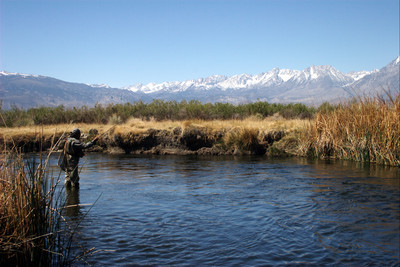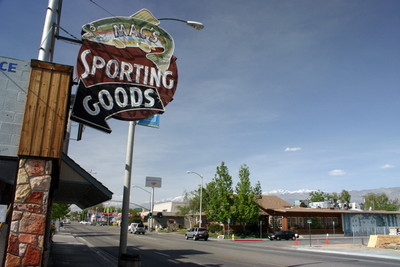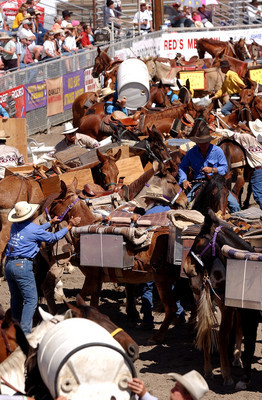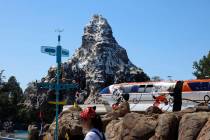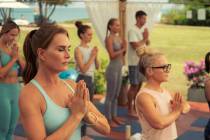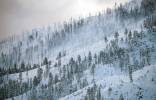Hot Spot
Tucked within the picturesque Owens Valley, between the eastern Sierra to the west and the White Mountains to the east, lies Bishop, Calif. During much of the year Bishop is a sleepy town, but once late spring arrives, it buzzes with activity.
Starting with the annual Mule Day Celebration over the Memorial Day holiday, and lasting through fall foliage season, Bishop becomes a hot spot not only for sightseeing but also for hikers, climbers, mountain bikers, anglers and those bound for the backcountry on horses or mules.
No matter what plans you have for the day, a good place to start is Schat's Bakery. Famous for its "Original Sheepherder's Bread," the bakery opened in 1938 to serve the Basque herders who grazed their flocks in the nearby mountains. How popular is this place? The bakery goes through 65,000 pounds of wheat monthly. Much of it goes into the sheepherder bread, a kind of sourdough in hand-shaped loaves. There are also pies, tarts and other pastries, and there are tables for the many customers who devour them on the spot. You also can order conventional breakfasts, with the old-fashioned kind of orange juice, wrung from an orange the same day you drink it.
The town is the jumping-off place for pack trips into the High Sierra. There's a widespread opinion that every person who would truly experience the West's magnificence must do it at least once from the saddle, with some packhorse or mule carrying the gear. Trips range from the affordable and basic, for which riders provide their own camping gear and food, to the decadent-dude variety for which outfitters provide the tents and pitch them, cook the food and pour the wine. Each trip can be catered to your specific interest, whether it's a relaxed family outing or an angler's assault on an alpine lake. Many groups prefer to stay put in one base camp, exploring the surrounding area by day, while others make it a movable feast, traveling from camp to camp.
Even if you aren't up for that type of adventure, you still can enjoy the magnificence of the surrounding landscape. One of the premier drives in the eastern Sierra is heading west out of town on Bishop Creek Road. In just 19 miles you will travel from the valley's high desert sage and open ranchland, at around 4,200 feet in elevation, to a landscape of pine trees, aspen groves and alpine lakes at nearly 10,000.
About seven miles up Bishop Creek Road is a scenic side road that takes you into the heart of the Buttermilks, a land of remarkable granite rock formations. The Buttermilks are a top destination for bouldering, a sport in which rock climbers focus on a single boulder and solve "problems" along short, yet intense routes. This is a great place to either try your hand at bouldering, or just watch other people doing it. These climbers don't use ropes, just powdered chalk on their hands to keep them dry for a better grip. And on the ground beneath the route, each carefully positions the bouldering equivalent of the trapeze artist's net: a thick "crash pad" of foam rubber to land on if the problem and gravity defeat the climber.
Within the Buttermilks you will find McGee Creek, a great place to stroll, have a picnic or do some bird-watching. From now through July, the water-loving plant community along the creek is home to the richest populations of breeding songbirds in the Eastern Sierra. The vast variety includes such especially interesting avians as red-breasted sapsuckers, yellow warblers, black-chinned hummingbirds and blackheaded grosbeaks.
Up farther along Bishop Creek Road you will find trailheads for hiking and backpacking into the high country, four major lakes celebrated for their fishing, and some of California's most glorious mountain scenery. Fishing isn't limited to the high country, though, and there are plenty of easily accessed waters in the valley. There are lakes, rivers and creeks to choose from. Most anglers come for the rainbow and wild brown trout but there are also bass, carp, perch and bluegill. The area is best known for fly-fishing but there are plenty of opportunities for those who prefer lures or bait.
One good drive close to Bishop, whether fishing or just out for some backcountry scenery, is Chalk Bluff Road, which runs between the lower Owens River and volcanic cliffs to the north. Along this two-mile gravel road, the river manages to serpentine 4.4 miles. For fishing, it's a catch-and-release area, so anglers must use barbless hooks and artificial lures. This road also accesses another popular rock-climbing place, called Happy Boulders.
Only four miles north of Bishop is the tiny town of Laws, home to the Laws Railroad Museum. Laws was built in the early 1880s as a company town for the narrow-gauge Carson and Colorado Railroad. The railroad was planned to extend all the way to the Colorado River, but when finished only went from Mound House near Carson City to Keeler, Calif. It has been referred to as "the railroad that was built 300 miles too long or 300 years too soon."
Many of the buildings are long gone from this old town, but significant survivors include the original 1883 railroad depot, the agent's house, oil and water tanks and a turntable used to rotate a locomotive so it could head back the way it came. And there are dozens of other historic buildings on site, many of them moved from the surrounding area to the museum grounds. Spread out over 11 acres, the museum features an old Western town with small buildings containing different exhibits. Some of the highlights include antique farm and mining equipment, an extensive display of bottles, a blacksmith shop, a wagon barn, an exhibit on pioneer ways of building and American Indian artifacts.
In the middle of the property you will find Engine No. 9, a steam locomotive nicknamed the Slim Princess, which is 100 years old this year. You can't take a ride on it, but you can get up into the driver's seat and pull the rope that rings the engine's bell.
Mule Days is Bishop's largest event and takes place annually over the Memorial Day holiday. This year's celebration, May 19-24, marks its 40th anniversary. What started as a small show in 1969, for just a couple of hundred spectators, now attracts some 30,000.
I have heard two stories of how Mule Days got started. One holds that it celebrated the start of pack season. The second asserts there was such a heavy snowfall that year, packing outfits couldn't get into the backcountry as early as usual. This concerned creditors, so locals put on a show to raise some funds.
One of Mule Days' highlights is the big Saturday parade, but it's a unique one.
"The parade is the longest nonmotorized parade in the country," said Barbara Laughon, a member of the Mule Days executive board.
The parade usually has around 200 entries, and the sponsors of some get very creative. If you see a classic car in this parade, mules will be pulling it.
More than 700 mules participate in more than 100 events.
"Pretty much what a horse can do, a mule can do better," Laughon explained.
Those familiar with rodeo and other equestrian events will recognize mule-powered versions of team driving, team roping, weight pulling, chariot racing and gymkhana. But Laughon's favorite event is the pack scramble.
"You won't find it anywhere else in the world," she said. "Teams of professional backcountry packers compete against each other for bragging rights."
Each team must wrangle its own mules out of a herd in the arena, pack them correctly, and race around to the finish line as spectators whoop, cheer and jeer. On average about nine teams compete, most of them from California and Nevada.
A few horses do share the spotlight, but they're the equine equivalent of NFL linemen. The Priefort Perchorons appear in an exhibition also known as "Texas Thunder," galloping around the arena with a human "riding Roman" -- that is, with one foot on each of two horses. It's difficult for the rider and perhaps death-defying, for these horses average 2,000 pounds and stand more than 18 hands high.
A visit to Bishop wouldn't be complete without spending some time at Mountain Light Gallery, established by the late wilderness photographer Galen Rowell. Rowell and his wife were killed in a plane crash in 2002 returning home to Bishop, but the gallery still shows his photos that captured so well the colors of the American West and the world. I do not believe any photographer, expert or absolute amateur, could spend 20 minutes here without learning how to take better pictures. I do not believe Cruella De Vil could see Rowell's pictures without being moved by their beauty.
And I myself cannot think of Bishop, in the spring, without longing to be there again with a friend and a camera and a picnic lunch, and a clear mountain morning stretching before us like a kingdom.
GETTING THERE
Location: Bishop, Calif., about 265 miles northwest of Las Vegas.
Directions: From Las Vegas, take U.S. 95 north about 115 miles to Beatty. Turn right and continue on U.S. 95 north for 52 miles. Turn left onto Nevada Route 266 and drive 45 miles. Turn left on California Route 168 for 38 miles. Turn right onto U.S. 395 north and follow for about 15 miles to Bishop.
Bishop Mule Days: May 19-24, Tri-County Fairgrounds, Bishop. (760) 872-4263, www.muledays.org.
Eastern High Sierra Packers Association: www.easternsierrapackers.com.
Brock's Flyfishing Specialists: Fly-fishing school and guide service. 100 N. Main St., (888) 619-3581, www.brocksflyfish.com.
Wilson's Eastside Sports: Equipment, maps and information for climbing, hiking, backpacking and bouldering. 224 N. Main St. (760) 873-7520, www.eastsidesports.com.
Laws Railroad Museum: Take U.S. 6 north 4.5 miles and go right onto Silver Canyon Road. Open all year 10 a.m. to 4 p.m. (760) 873-5950, www.thesierraweb.com.
Mountain Light Gallery: Open Sundays-Thursdays 10 a.m.-6 p.m., extended evening hours on Fridays and Saturdays. 106 S. Main St., (760) 873-7700, ww.mountainlight.com.
Bishop Chamber of Commerce and Visitors Bureau: Open 10 a.m.- 5 p.m. Mondays-Fridays and 10 a.m.-4 p.m. weekends. 690 N. Main St., (888) 395-3952, www.bishopvisitor.com.
Inyo National Forest Camping: (760) 935-4489, www.reserveusa.com.



